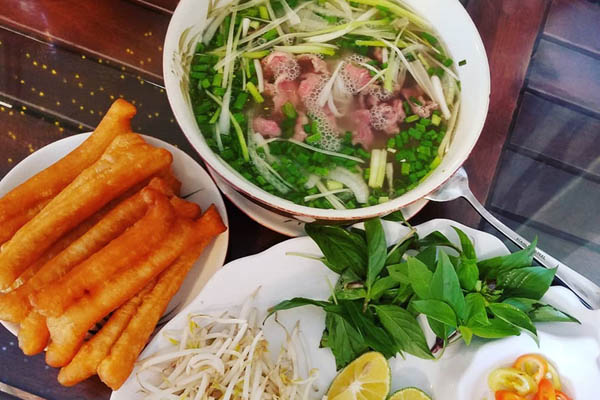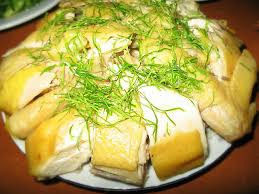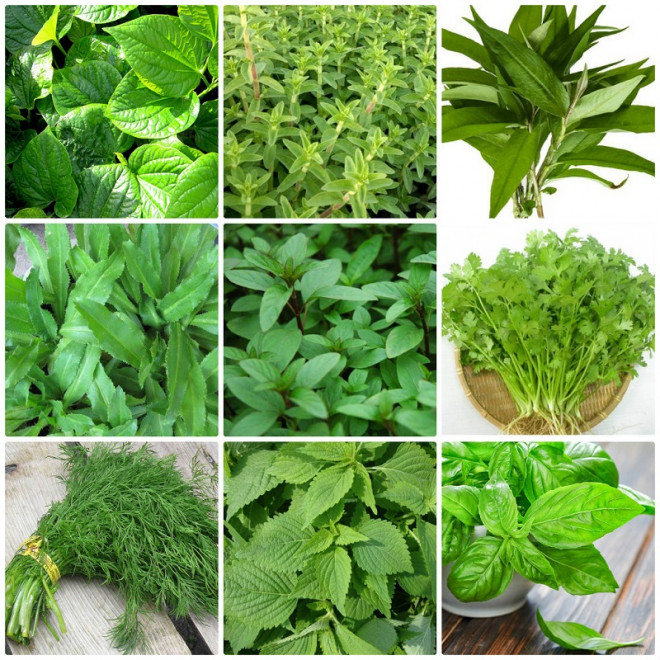The art of adding spices to pho, radish and the delicate way of using lemon leaves for Hanoian dishes
The art of adding spices to pho and rai dishes of Hanoians creates its own unique flavor and special appeal – especially with traditional dishes.
The story of spices for the dish
The famous French chef Didie Cooclu discovered that spices have created their own unique flavor, uniqueness and special appeal of each Hanoi dish – especially traditional ethnic dishes such as pho and Vietnamese dishes. eat with worms.
Some types of vegetables and spices used by Hanoians. Illustration.
Mr. Didie Cooclu also knows Vietnamese folk songs:
Chicken with lemon leaves
The pig grumbled and bought me onions
Crying dog standing crying sitting
Mom, go to the market to buy me galangal
The buffalo looks sideways
I had galangal, leave the garlic for me.
In the past, people in the regions were easy to use, simple when using spices, to the extent that in the garden, in the market, they were ready to use whatever they wanted.
The salad is roughly the same, with marjoram, perilla, dog basil, and Chinese flavor being the basics. Neighbors run to the other house to pluck a handful of vegetables, pick peppers, or scrape off the soil to break ginger and galangal roots to put in a fragrant dish – but not fussy about eating this dish, you must definitely add vegetables. that spice.
For example, the dish of Hai Phong and Hai Duong people put guava leaves and laksa leaves in the dish to highlight the taste. But the people of Nam Dinh and Thai Binh give Gac leaves and young ginger to find it delicious. Nghe An and Ha Tinh people give ginger and turmeric leaves. As for Hanoians, they just act with flowers and dill. Only tangerine peel is used everywhere.
My sister married a Hai Phong man, cooked meals at her husband’s house in Hanoi style and was praised by her husband’s family.
Particularly, the sister’s dish is made in the right style of Hai Phong. I tried it once and it was delicious. But she brought rai from Hai Phong to my kitchen and fried them for the whole family, so I definitely made them with dill and scallions.
People on the outskirts of the city eat fish sauce in addition to tangerine peels, sour star fruit, old ginger, people will earn a basket of many kinds of spices, from perilla, marjoram, herbs, coriander, fig leaves, hope, buds. guava, sesame buds, cloves… like eating with fish salad.
The people of the old town who eat fish sauce also have tangerine peels, sour star fruit, and old ginger, but they also add chopped onions, pineapple, coriander, celery, chamomile (and when the celery is too old, it is replaced with a little corn. cabbage).

Pho many Hanoians like to eat very hot, so they don’t give spices. Illustration.
Spices for Pho
Pho is the same, wherever you go to eat pho, it is difficult to get the same delicious taste as Hanoi pho.
My personality is always inquiring and discovering, so wherever I go, there are pho restaurants, I also swoop in to try a bowl to see how the flavors and spices of the regions are.
I see that in other provinces, when eating pho next to a plate of lemon and chili, almost all of them have a plate of herbs.
Pho in Saigon and the southern provinces is a plate of basil and raw bean sprouts.
In the northern provinces, it is usually a plate of mint herbs, sometimes even slices of thinly sliced banana flowers.
But when Hanoians eat pho, I find that they rarely pick up herbs and vegetables like people from other regions.
It seems that Hanoians do not want spices to reduce the heat in the fields – the dominant feature of a bowl of pho.
Hanoi beef noodle soup, in addition to coriander (or herbs) on the bowl, is not served with any spices – except fresh lemon wedges and slices of chili.
With chicken noodle soup, many restaurants sprinkle some lemon leaves – a spice that honors the taste of boiled chicken.
Just a handful of finely chopped lemon leaves like a hair sprinkled lightly on a bowl of pho, or a plate of chicken, it looks luxurious and very attractive.

Chicken is often sprinkled with lemon leaves to make the dish more delicious. Illustration.
How to use herbs and spices with lemon leaves
Lemon leaves are also very “good” with boiled snails, spring rolls, roasted pupae.
At the end of autumn and early winter, the rice fields have just been harvested, the golden grasshoppers are roasted with a little salt and pepper, sprinkled with a few strands of young lemon leaves – guaranteed that the drinking wings compete to pick up chopsticks.
Particularly for lemon leaves for chicken noodle soup, processing dishes with chicken must also be in tune.
Proper use of lemon leaves must also be learned because it is not simple, but it is important not to rush to handle it.
Lemon leaves must choose the leaves of the cake (not young, not old, not deep, not curled, not wrinkled) – the leaves have a pale green color with a golden light.
The lemon leaves chosen for the dish are only mild, but too yellow means that the lemon leaves are old, have stiff veins and are less fragrant.
Too young lemon leaves are also less fragrant and quickly wither.
Lemon leaves are washed thoroughly, then wipe each leaf with a soft cloth (some people are careful to remove the hard petioles, but perhaps not so necessary).
Then arrange the leaves into small cubes, put on a flat cutting board, use a sharp knife, cut quickly but gently.
The reason why you have to cut lemon leaves lightly is because you have to cut lemon leaves with a strong hand, but you have to chop the cutting board, a dull knife will not be able to cut the lemon leaves properly, but will also crush the fibers, sprinkle on dishes that are less beautiful, and lose the aroma. .
Many people in the kitchen in a hurry – including me – pinched some wet lemon leaves and cut them with scissors, telling themselves that the restaurant is not a guest table.
But then I suddenly remembered my Mother. When I was a girl, my mother closely taught women how to do housework, nothing like that. Now that I have become a mother, if I become a grandmother, if I do it carelessly, my children and grandchildren will be even more careless in the future.
at Blogtuan.info – Source: 24h.com.vn – Read the original article here




